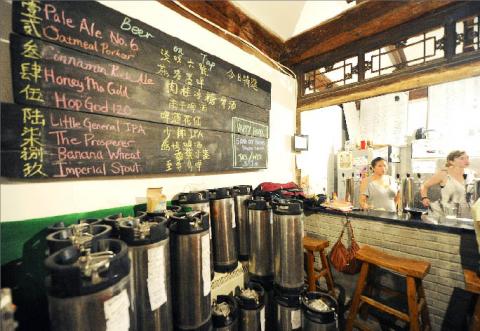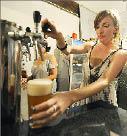In a poky room in a backstreet of Beijing, self-taught brewer Carl Setzer uses spicy Sichuan peppercorns, oolong tea leaves and cinnamon to invent beer flavors suited to Chinese tastes.
The burly American runs Great Leap Brewing, one of a small, but growing number of microbreweries in China hoping to entice drinkers in the world’s biggest beer market with their hand-crafted lagers, ales and stouts.
Chinese drinkers buy more than 40 billion liters of beer a year, but the vast majority are consuming cheap, locally produced lagers that cost as little as US$0.50 a bottle.

Warning: Excessive consumption of alcohol can damage your health
Photo: AFP
Snow beer, which is brewed by SABMiller PLC and its Chinese partner China Resources Enterprises Ltd, is the biggest-selling beer in the country, followed by Tsingtao, which is made by one of China’s oldest and best known breweries.
However, Setzer and other microbreweries operating in major cities such as Beijing and Shanghai hope to attract China’s growing middle class, who like the taste of foreign beer and can afford to pay 15 times the cost of a local brand.
“You’ve got 50 or 60 million beer drinkers in this country — let’s aim at 10 percent of that and see if we can get a market going for people who want something that is a little bit better, a little bit different,” Setzer said.

Warning: Excessive consumption of alcohol can damage your health
Photo: AFP
Setzer, who says his beer has “flavor” and “soul” unlike local brew, produces 800 liters a week for the hundreds of Chinese and foreign expatriate drinkers who stop by his traditional courtyard for a glass of ale.
Ho Punyu, 34, is a regular at Great Leap Brewing after foreign friends introduced him to the bar’s handcrafted ales a year ago.
“Tsingtao and Yanjing beer taste like water,” said Ho, an investment adviser in Beijing, referring to China’s second-best-selling beer and another brand local to Beijing. “I look at things in term of value — the taste is good, the price is right.”
At the Boxing Cat Brewery in Shanghai, where a pint of pale ale costs 45 yuan (US$7), nearly half the customers are Chinese — which brewmaster Michael Jordan says proves there is a market for top-notch beer in China.
“The business here is in its infancy so there’s a lot of opportunity,” said Jordan, who brews 2,000 liters a week. “It is also challenging because Chinese culture is not used to craft beer — there’s a lot more flavor complexity.”
China has been making beer for thousands of years, according to the American Association of Wine Economists (AAWE), but it is better known for its potent white liquor, baijiu, distilled from grains such as sorghum and rice.
Beer consumption has exploded in China. The AAWE, a non-profit organization made up of economists from around the world, said the country consumes 40 billion liters a year, compared with 150,000 million liters in 1961.
However, on a per capita basis, China lags far behind beer-swilling countries in Europe, with the average Chinese person consuming 24 liters a year, compared with more than 160 liters in Ireland and the Czech Republic, AAWE said.
Other estimates put Chinese per capita beer consumption at about 32 liters.
At 5 percent to 10 percent a year, the growth in China’s beer market is much slower than for wine, which is becoming the tipple of choice for those seeking to impress, said Shaun Rein, managing director of China Market Research Group in Shanghai.
“We expect red wine consumption to be growing 20 to 30 percent a year for the next five years minimum — it’s one of the hottest sectors to be in right now,” Rein said.
Setzer said he is constantly experimenting with local ingredients to come up with new beer flavors to entice more customers to his rustic microbrewery in central Beijing.
Some of his most successful creations so far are the Iron Buddha Blonde made with oolong tea and the Honey Ma Gold, which is made from spicy Sichuan peppercorns and organic honey.
“The Honey Ma is the 33rd attempt ... I brewed it 33 different times before I found one that I just loved,” Setzer said, as he sipped a pint of ale. “The more you do something, the more crazy you want to be.”
Analysts say the success of microbreweries in Shanghai and Beijing has been driven by foreign expatriates and Chinese who have lived abroad or work with Westerners, and they are unlikely to appeal to drinkers outside the major cities.
Most beer in China is sold in large bottles in restaurants, which mainly stock local brands.
“I don’t think microbreweries will ever get hugely popular because there is a different taste and different price point and conception of what beer is,” Rein said. “Typically Chinese like more watered down versions of beer — it is a lot lighter in taste.”
Sam Mulligan, director of market research group DDMA in Shanghai, agrees.
“Beer is considered an adult refreshment rather than a serious drink in China,” Mulligan said. “You see people drinking it for breakfast.”

MULTIFACETED: A task force has analyzed possible scenarios and created responses to assist domestic industries in dealing with US tariffs, the economics minister said The Executive Yuan is tomorrow to announce countermeasures to US President Donald Trump’s planned reciprocal tariffs, although the details of the plan would not be made public until Monday next week, Minister of Economic Affairs J.W. Kuo (郭智輝) said yesterday. The Cabinet established an economic and trade task force in November last year to deal with US trade and tariff related issues, Kuo told reporters outside the legislature in Taipei. The task force has been analyzing and evaluating all kinds of scenarios to identify suitable responses and determine how best to assist domestic industries in managing the effects of Trump’s tariffs, he

TIGHT-LIPPED: UMC said it had no merger plans at the moment, after Nikkei Asia reported that the firm and GlobalFoundries were considering restarting merger talks United Microelectronics Corp (UMC, 聯電), the world’s No. 4 contract chipmaker, yesterday launched a new US$5 billion 12-inch chip factory in Singapore as part of its latest effort to diversify its manufacturing footprint amid growing geopolitical risks. The new factory, adjacent to UMC’s existing Singapore fab in the Pasir Res Wafer Fab Park, is scheduled to enter volume production next year, utilizing mature 22-nanometer and 28-nanometer process technologies, UMC said in a statement. The company plans to invest US$5 billion during the first phase of the new fab, which would have an installed capacity of 30,000 12-inch wafers per month, it said. The

Taiwan’s official purchasing managers’ index (PMI) last month rose 0.2 percentage points to 54.2, in a second consecutive month of expansion, thanks to front-loading demand intended to avoid potential US tariff hikes, the Chung-Hua Institution for Economic Research (CIER, 中華經濟研究院) said yesterday. While short-term demand appeared robust, uncertainties rose due to US President Donald Trump’s unpredictable trade policy, CIER president Lien Hsien-ming (連賢明) told a news conference in Taipei. Taiwan’s economy this year would be characterized by high-level fluctuations and the volatility would be wilder than most expect, Lien said Demand for electronics, particularly semiconductors, continues to benefit from US technology giants’ effort

‘SWASTICAR’: Tesla CEO Elon Musk’s close association with Donald Trump has prompted opponents to brand him a ‘Nazi’ and resulted in a dramatic drop in sales Demonstrators descended on Tesla Inc dealerships across the US, and in Europe and Canada on Saturday to protest company chief Elon Musk, who has amassed extraordinary power as a top adviser to US President Donald Trump. Waving signs with messages such as “Musk is stealing our money” and “Reclaim our country,” the protests largely took place peacefully following fiery episodes of vandalism on Tesla vehicles, dealerships and other facilities in recent weeks that US officials have denounced as terrorism. Hundreds rallied on Saturday outside the Tesla dealership in Manhattan. Some blasted Musk, the world’s richest man, while others demanded the shuttering of his